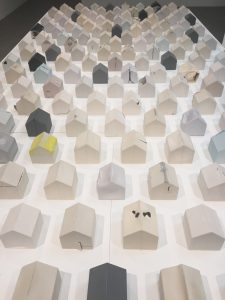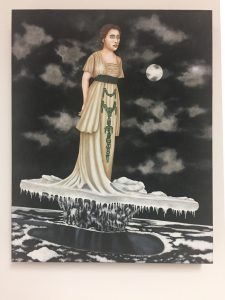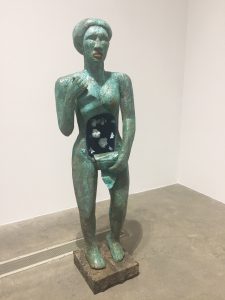MOAH: Lancaster Museum of Art and History
- Fabrik
- May 8, 2018
- 5 min read

Nestled in the desert landscape between the San Gabriel Mountain Range to the south and the Tehachapi Mountain Range to the north, in the heart of the burgeoning bedroom community of Lancaster, is an unexpected oasis of art and culture. Founded in 1986 as the Lancaster Museum/Art Gallery, today, the Lancaster Museum of Art and History (MOAH) is aggressively advancing an agenda of art appreciation and artist engagement in the Antelope Valley—and beyond.
MOAH is located on a welcoming block of Lancaster Boulevard in the BLVD Cultural District. Here piped music infuses the air, murals make the outside walls come alive and high school students drop by Thursday afternoons when the museum stays open late. Even the art cognoscenti of Los Angeles—those with access to the competing world-class art attractions of the big city—make the 70-mile trip to check out MOAH’s ambitious curatorial program.
The museum’s agenda wasn’t always so far-reaching. Originally housed in an 8,000 square foot building on Sierra Highway, its mission focused then on showing the work of local artists and preserving a permanent collection of artifacts and records related to Antelope Valley history. As the city grew, the museum evolved. In 2010, the City broke ground on a new site, the outcome of a public/private partnership between the City of Lancaster and Steve Eglash and Scott Ehrlich, founders of InSite Development. MOAH’s manager and curator, Andi Campognone, came aboard in 2011 to help steer the museum’s vision in concert with the new building, which opened in 2012.
Since then, MOAH has gone on to do much more than just organize exhibitions. In fact, art shows account for a mere two percent of its activities, said Campognone in a recent interview with Fabrik. The thrust of the museum’s agenda is focused on public engagement: connecting with school kids, local residents and artists. “Everyone always goes back to, ‘Oh, the museum has this great show,’” said Campognone, formerly a curator at Riverside Art Museum. “They think it’s just this building that houses exhibitions, and for two and a half months there’s this kind of static engagement with these inanimate objects.”
Campognone is emphatic about correcting this misperception. “It’s not just our job to show the work. It’s also our job to create the next generation of human beings who are interested in understanding culture on any level. Just plopping a museum in the middle of the desert and hoping that the handful of people who are sophisticated enough to value the arts will show up… that’s kind of like the icing on the cake. The most important part is having that museum supplement all the young people with experience and education and engagement. That’s where it starts.”
Unlike most museums, MOAH is a municipal institution, overseen by Lancaster’s director of parks, recreation and arts, which gives Campognone considerable leeway in charting the museum’s course “When it comes to the agenda for the museum, it’s me and another curator,” she said, referring to Robert Benitez, curator of MOAH: Cedar, the museum’s nearby satellite exhibition space. “We have a foundation board, but their sole job is to fundraise, so our collecting is based on what is relevant and what fits our mission, not supporting our board members’ collections,” said Campognone. “Our collecting mission and our exhibition mission revolve around accessibility for the community.”
Addressing the need for public engagement, especially in a somewhat remote location, MOAH has a vast range of outreach initiatives. For example, the museum’s foundation pays for school buses so local kids can visit. They get a tour, engage in hands-on art making in the MOAH classroom and view the outdoor murals. “We talk [to them] about public art, and in that component, for young people, it’s pride of ownership in your own community,” Campognone said.
Not a kunsthalle, MOAH also has a permanent collection. To kick off the museum’s contemporary collection, Eglash and his wife, artist Gisela Colon, donated several pieces, hoping to inspire other collectors to do the same. The collection has grown each year since MOAH opened. As Campognone noted, it’s crucial for the collection to reflect the relationship between the aerospace industry—long centered in the immediate vicinity—and movements in contemporary art. “We wouldn’t have the resin artists, we’d have none of the Light and Space artists, none of the Finish Fetish culture, none of what’s happened in painting. All of that directly comes from materials that were developed through aerospace and the military; and that happened in the Antelope Valley,” she said. Edwards Air Force Base, Boeing, Lockheed and Northrop Grumman are all nearby. Leveraging this aerospace connection, the museum is planning a show with NASA in 2020.
Also vital is the museum’s dedicated effort to engage emerging and mid-career artists from the LA area, one of the reasons Campognone said she decided to stay at the museum when her initial contract ended in 2012 after the opening of the new building. “Right around that time there was all that uproar happening at MOCA. This was an opportunity to support the LA art makers. MOCA, when it started, that was its mission, to focus on contemporary art being made in Los Angeles. Over the years, it just got further and further away from that, where now it’s blue chip shows from artists from everywhere else but Los Angeles. I was hearing from all these [local] artists, ‘Where do we go? There isn’t a quality exhibition space that supports us.’ I thought, ‘I want to be here because I think I have an opportunity to fill that void.’”
Filling that void has paid off for artists and MOAH alike. “It’s been a kind of a blessing,” said Campognone. “There’s so much work being made in Los Angeles that’s valid and relevant that isn’t even getting two looks by the larger museum organizations, but we have this beautiful space, why not show it? Why not support it, and why not be a steppingstone for emerging artists. Why not help some of those mid-career artists who need that book produced or who need that film made, or to help them in that part of their career?”
Fittingly, the current exhibition, It Takes a Village (through April 22, 2018), features the work of LA artists. Curated by Betty Ann Brown, the headliner exhibit, Memory & Identity: The Marvelous Art of Betye, Lezley and Alison Saar, is a survey of the work of the extraordinary artist family: the mother and her two daughters. MOAH has published a catalogue to accompany the exhibit, because, as Campognone said, “The show doesn’t end when the show ends.” Related exhibits by Richard S. Chow, Lisa Bartelson, Jane Szabo, Wyatt Kenneth Coleman, Rebecca Campbell and Scott Yoell, investigate the theme of family, identity and community from different angles. It’s no coincidence that the community theme echoes the museum’s mission—and raison d’être.
The last exhibit at MOAH Cedar, Monica Wyatt: Continuum, (January 20-March 3), showcased the work of the Los Angeles based assemblage artist.









